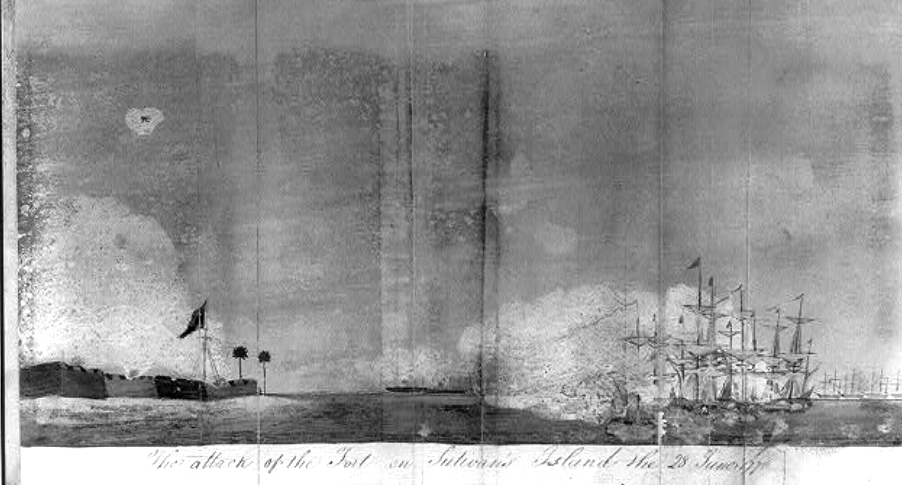
EDITOR’S NOTE: Today (June 28) is the 243rd anniversary of the Battle of Sullivan’s Island.
S.C. Encyclopedia | The Battle of Sullivan’s Island was the first major patriot victory in the Revolutionary War. In February 1776, after British plans to capture Charleston were revealed, South Carolina patriots began construction of a fort on Sullivan’s Island close to the main shipping channel at the mouth of Charleston harbor. Colonel William Moultrie was given command of the island’s forces and ordered to supervise the fort’s construction.
The unnamed fort was to be a square with five-hundred-foot-long walls and a bastion at each corner. It was built of thousands of palmetto trees cut to make two parallel log walls sixteen feet apart and more than ten feet high. The space between the walls was filled with sand. By late June only the two walls and bastions facing the channel were complete; thirty-one cannons were in place, and fewer than four hundred soldiers garrisoned the incomplete fort. At the other end of Sullivan’s Island, three hundred soldiers were positioned at Breach Inlet to block the British from crossing from Long Island (Isle of Palms) and attacking the fort from the rear.
A British fleet, which arrived on June 1, included nine men-of-war mounting almost three hundred cannons. On June 8 a British surrender demand was rejected, and the next day British infantrymen landed on Long Island. On June 28 the British ships advanced to attack the Sullivan’s Island fort. By 11:30 a.m. six warships were in position and opened fire. The fort’s guns soon responded. Not long after the bombardment began, three more British warships attempted to move into position between Sullivan’s Island and the mainland, fire into the fort’s unprotected rear, and block patriot troops from reinforcing the fort. But the movement failed when all three ran aground on the sandbanks in the harbor’s mouth. Two later freed themselves, while the third remained hard aground.
The bombardment continued into the evening, but the fort withstood the pounding from the British heavy guns. Its palmetto-log and sand walls absorbed the solid shot and shells, resulting in little structural damage. At the same time, patriot rounds tore into the wooden warships. During the afternoon when the British on Long Island attempted to cross Breach Inlet, patriots on Sullivan’s Island were able to turn them back.
At 9:00 p.m. the British ceased their attack and pulled out of the fort’s range. Several warships had been damaged, and more than two hundred sailors were casualties. Inside the fort fewer than forty patriots had suffered the same fate. The next day the British set the grounded ship on fire, which exploded when the flames reached the powder magazine. The British soon withdrew, leaving Charleston free from attack until 1780.
Shortly after the battle, the fort was named Fort Moultrie in honor of its commander. Fort Moultrie is administered as part of Fort Sumter National Monument, a unit of the National Park Service.
Today, South Carolinians remember the Battle of Sullivan’s Island as “Carolina Day” every June 28.
- Eight things to know about Carolina Day, by Jeff Quinton
— Excerpted from an entry by Richard W. Hatcher III. his entry may not have been updated since 2006. To read more about this or 2,000 other entries about South Carolina, check out The South Carolina Encyclopedia, published in 2006 by USC Press. (Information used by permission.)



Pingback: Charleston Currents – BRACK: Celebrate Carolina Day with gusto